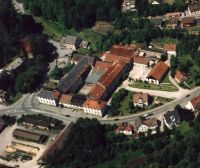Vous êtes ici :
Abbayes > Allemagne > Rhénanie-du-Nord-Westphalie > Marsberg > Bredelar
Bredelar
 Pas de description en français...
Pas de description en français...Description en anglais
In the year 1196, the Archbishop of Cologne summoned monks from the Cistercian Abbey in Hardhausen to establish a new abbey in a former Premonstratensian convent nearby that had been founded in 1170 but disbanded shortly thereafter. As abbey and landholder, the Zisterze Breidelare would go on to spur the economic, intellectual and spiritual growth of the northeast Sauerland region. The Bredelar Abbey thrived for a good 600 years. In the 13th century its distinguished scriptorium produced the three-volume, richly illuminated Bredelar Bible, which is today kept in the Hessian State and University Library in Darmstadt. Other manuscripts from the abbey's library are preserved today in Wiesbaden, Berlin, Boston, Liverpool, Manchester, Oxford, Paris and Washington. The remaining building fabric of the abbey is based on a construction plan from 1726. In 1804 the abbey was disbanded in the course of secularisation. From 1828 to 1932, the monastery was home to an ironworks and foundry called Theodorshütte. Theodorshütte was initially set up as both smeltery and foundry of iron, with the first of its three blast furnaces erected in the former abbey church. From 1876 the iron foundry formed the centre of operations, producing extremely large machine parts, building components, iron window frames and stoves. In the latter half of the 20th century, the building progressively deteriorated and fell into disrepair. In 2000, the friends' society Kloster Bredelar e.V. was founded with the aim of restoring the complex for use as a community and cultural centre.
Cacher
Cacher
Description en allemand
In ein 1170 gegründetes, aber nach nur kurzer Zeit aufgelöstes Kloster von Prämonstratenserinnen berief der Erzbischof von Köln im Jahre 1196 Mönche aus der benachbarten Zisterzienserabtei Hardehausen. Die Zisterze Breidelare förderte fortan in wirtschaftlicher, geistiger und geistlicher Hinsicht wie auch als Grundherr die Entwicklung im nordöstlichen Sauerland. Mehr als 600 Jahre währte die klösterliche Zeit. Im 13. Jahrhundert wurde in dem bedeutenden Skriptorium die dreibändige, mit Miniaturen reich bebilderte Bredelarer Bibel geschrieben, die sich heute in der Hessischen Landes- und Hochschulbibliothek in Darmstadt befindet. Weitere Handschriften aus der Klosterbibliothek werden in Wiesbaden, Berlin, Boston, Liverpool, Manchester, Oxford, Paris und Washington aufbewahrt. Das Klostergebäude beruht in seinen wesentlichen Zügen auf einem Bauplan von 1726. 1804 wurde die Abtei im Zuge der Säkularisation aufgelöst. Danach produzierte von 1828 bis 1932 hier ein Betrieb der Schwerindustrie, die Theodorshütte. Sie war Eisenhütte und -gießerei. Der erste der drei Hochöfen stand in der ehemaligen Abteikirche. Ab 1876 konzentrierte sich der Betrieb auf die Gießerei großer Maschinen- und Bauteile, eiserner Fenster und Öfen. Vor allem in der zweiten Hälfte des 20. Jahrhunderts war das Bauwerk zunehmend dem Verfall preisgegeben. Im Jahr 2000 gründete sich der Förderverein Kloster Bredelar e. V., der sich der Restaurierung und Nutzung als Begegnungs- und Kulturzentrum annimmt.
Cacher
Cacher
[ Retour ]


